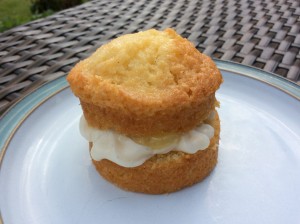
In this section I will try and give some helpful cake baking tips to help your cakes turn out great.
Weigh and measure your ingredients. Cake making is a science and things can go horribly wrong when you have too much raising agent, or too much flour. Lots of American recipes use cups for measurements. I like to use cups for liquids but for anything else you get a more consistent results if you weigh the ingredients, and its also less messy. When using spoons use a level spoon unless otherwise stated. I have some old fashioned scales which small children love to help with, the other advantage is the battery never runs out. Use large eggs for recipes. For sponge cakes weigh the eggs to ensure consistent results.
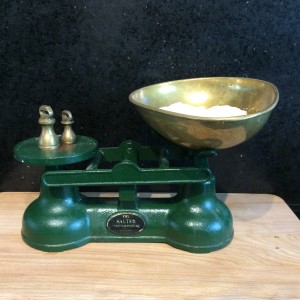
Ensure that your eggs and butter are at room temperature. It makes the cakes much hard to mix when they are cold and it tends to lead to a heavier cake. On a really hot day the butter might be too soft, the right texture is like cold cream cheese, if its too hot put back in the fridge for a few minutes.
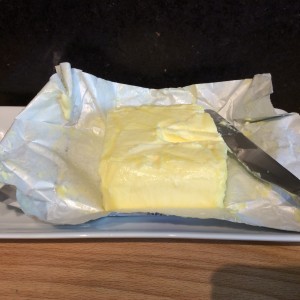
Use the right raising agent. Baking powder and baking soda do different things. If you add too much a recipe you can sometimes taste it and you risk that the cake might rise up too early and then sink in the middle. Always check it is in its sell by date.
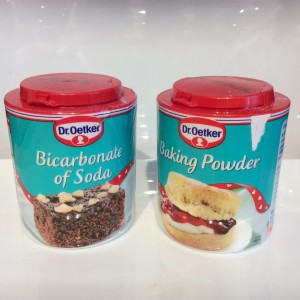
To make self raising flour add 1 level tablespoon (3 teaspoons) of baking powder to 225g of plain flour. If you need a different amount use a multiple of the flour e.g make up 450g of flour with 2 tablespoons of baking powder, or two 15g packets of German Backpulver. To ensure it is well mixed put it in a large storage jar and shake to mix.
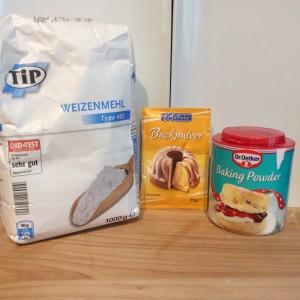
Sieve the flour and raising agents to ensure they are well mixed, this should help get an even rising cake.
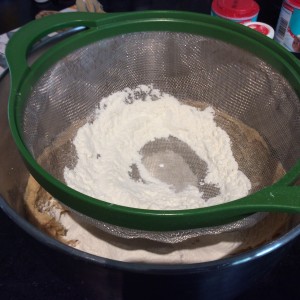
Don’t over mix the mixture. Over working the flour can lead to heavy stiff cakes. Mix till the flour and other ingredients are just combined. The picture below shows what you should be aiming for when making a sponge cake.
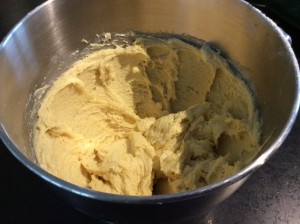
Line or oil your cake tins, if you are using them. It stops the mixture from sticking. Alternatively use paper cases for cup cakes. I have just bought some mini cake tins and they work really well giving a golden brown outside finish without the need for extra cases. You can use silicon cases but I find the cake edges are not as golden brown.
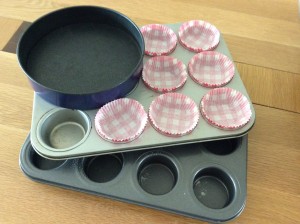
Try and spread out your mixture evenly, that way your cakes should be ready at the same time. An ice cream scoop makes it a lot easier for cup cakes.
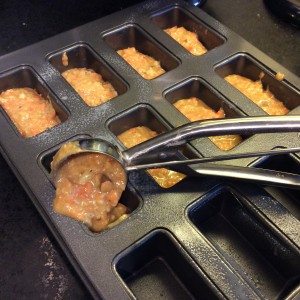
Preheat your oven before putting the cakes in. It helps take some of the guess work out of when they will be ready. Don’t open the oven until the minimum time is up unless you think your cakes are starting to burn. Letting cold air in before the cakes are cooked can cause them to sink in the middle. When the minimum time is up, first check the colour, then use a skewer to poke the cake, if it comes out clean they are done. If not check again in another couple of minutes. If you are making banana bread the cake is quite sticky test that the top has some spring in it and that it has a good golden colour. If your cakes rise up and then sink it is due to there even being too much raising agent or that your oven is too hot. Try cooking at a lower temperature next time round.
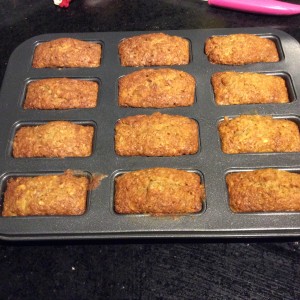
Leave to cool in tin for 5 minutes, then remove from the tin and leave to cool on a wire rack. This stops the cakes from getting a soggy bottom.
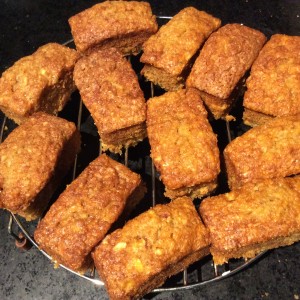
Its easier to make icing in a food processor. Icing sugar normally has lots of lumps in it. Blend it on its own first before adding the other ingredients. Add the liquid a little bit at a time to try and ensure it doesn’t get too runny. Ice the cakes when they are completely cold.
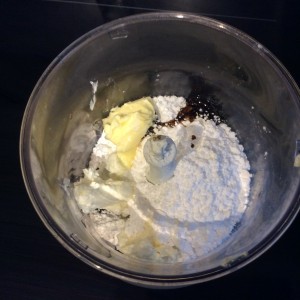
Store cakes in an airtight tin. Most cakes don’t need to go in the fridge unless they contain cream. Fridges tend to dry out cakes.

Pingback: side effect of hydroxychloroquine
Pingback: hydroxychloroquine over the counter in canada
Pingback: hydroxychloroquine for aml
Pingback: chloroquine and hydroxychloroquine
Pingback: dapoxetine 30 mg
Pingback: ivermectil alternative pills
Pingback: vidalista tadalafil black 800
Pingback: priligy usa
Pingback: prednisone 50mg side effects
Pingback: prednisone 5 21 dose pack
Pingback: stromectol online without prescription
Pingback: stromectol prescription
Pingback: stromectol over the counter cvs
Pingback: when does tadalafil patent expire
Pingback: doxycycline dose for dogs in pounds
Pingback: albuterol prices walmart
Pingback: stromectol 100mg
Pingback: prednisone 20 tablet uses
Pingback: durvet ivermectin
Pingback: best prices on cialis online
Pingback: ivermectin dose
Pingback: stromectol no prescription
Pingback: ivermectin 6 mg
Pingback: erythromycin antibiotic dose
Pingback: viagra otc canada
Pingback: how is ivermectin made
Pingback: olumiant cost
Pingback: aralen 200mg cost
Pingback: olumiant price usa
Pingback: 10 zanaflex
Pingback: Anonymous
Pingback: Anonymous
Pingback: buy ivermectin online
Pingback: ivermectin tablets for sale
Pingback: ivermectin australia
Pingback: ignition casino community
Pingback: buy stromectol
Pingback: buy prednisone 5mg
Pingback: cialis walmart
Pingback: best price for tadalafil
Pingback: ivermectin 0.08
Pingback: illegal to order viagra online
Pingback: generic ivermectin for humans
Pingback: best price for cialis
Pingback: where to order generic viagra
Pingback: ivermectin 6mg tablet for lice
Pingback: peptides tadalafil
Pingback: cialis pills for cheap
Pingback: canadian pharmacies
Pingback: sildenafil pills generic brand
Pingback: cialis com
Pingback: buy cialis
Pingback: ivermectin use
Pingback: sildenafil pills prescription
Pingback: generic sildenafil pills online
Pingback: cialis pills
Pingback: cost for generic cialis
Pingback: tadalafil peptides
Pingback: posologie prednisone 20mg mylan
Pingback: prednisone 20mg sciatique
Pingback: merck molnupiravir
Pingback: cialis wirkung
Pingback: generic cialis pills on line
Pingback: can you buy cialis without a prescription
Pingback: best price for cialis
Pingback: ivermectin for humans over the counter
Pingback: prednisone
Pingback: female viagra sildenafil
Pingback: cialis price walmart
Pingback: real money casino
Pingback: tadalafil cialis
Pingback: where to get ivermectin
Pingback: india covid ivermectin
Pingback: online casino games real money
Pingback: cialis price walmart
Pingback: cheap viagra
Pingback: tadalafil otc
Pingback: ivermectin pills for people
Pingback: ivermectin 3 mg over the counter
Pingback: ivermectin manufacturers
Pingback: where can you get ivermectin
Pingback: ivermectin 6 mg pills
Pingback: buy ivermectin
Pingback: cialis goodrx
Pingback: where can you get cialis
Pingback: ivermectin 12 mg
Pingback: purchase ivermectin
Pingback: ivermectin 3mg for sale
Pingback: buy ivermectin pills
Pingback: ivermectin 6mg
Pingback: ivermectin kaufen
Pingback: lasix 40 mg buy
Pingback: furosemid
Pingback: purchasing ivermectin
Pingback: stromectol tablets uk
Pingback: ivermectin price uk
Pingback: ivermektin
Pingback: ivermectin 12mg online
Pingback: where can i purchase ivermectin
Pingback: buy cialis
Pingback: luckyland slots casino
Pingback: ivermectin antiviral
Pingback: what does hydroxychloroquine treat
Pingback: buy stromectol 3 mg
Pingback: jeffrey smith ivermectin
Pingback: cialis over the counter at walmart
Pingback: stromectol buy uk
Pingback: mectin ivermectin
Pingback: ivermectin over counter
Pingback: cialis over the counter
Pingback: mazhor4sezon
Pingback: filmfilmfilmes
Pingback: gRh9UPV
Pingback: ivermectin 15 mg
Pingback: hydroxychloroquine study
Pingback: 9-05-2022
Pingback: kinoteatrzarya.ru
Pingback: TopGun2022
Pingback: Xvideos
Pingback: XVIDEOSCOM Videos
Pingback: ivanesva
Pingback: hydroxychloroquine buy online amazon
Pingback: tadalafil medication
Pingback: Netflix
Pingback: Zvezdy-v-Afrike-2-sezon-14-seriya
Pingback: Krylya-nad-Berlinom
Pingback: FILM
Pingback: designchita.ru
Pingback: YA-krasneyu
Pingback: design-human.ru
Pingback: designmsu.ru
Pingback: vkl-design.ru
Pingback: irida-design.ru
Pingback: stromectol merck
Pingback: Intimsiti-v-obhod-blokirovok
Pingback: psy-
Pingback: projectio
Pingback: moskva psiholog online
Pingback: slovar po psihoanalizu laplansh
Pingback: psy online
Pingback: do-posle-psihologa
Pingback: uels ukrain
Pingback: bahis siteleri
Pingback: price of ivermectin tablets
Pingback: DPTPtNqS
Pingback: qQ8KZZE6
Pingback: D6tuzANh
Pingback: wKs3jE4x
Pingback: SHKALA TONOV
Pingback: Øêàëà òîíîâ
Pingback: russianmanagement.com
Pingback: chelovek-iz-90-h
Pingback: 3Hk12Bl
Pingback: 3NOZC44
Pingback: 01211
Pingback: tor-lyubov-i-grom
Pingback: film-tor-2022
Pingback: hd-tor-2022
Pingback: hdorg2.ru
Pingback: ivermectin 0.1 uk
Pingback: Psikholog
Pingback: netstate.ru
Pingback: 2coleman
Pingback: Link
Pingback: ivermectin 4 tablets price
Pingback: tor-lyubov-i-grom.ru
Pingback: psy
Pingback: chelovek soznaniye mozg
Pingback: bit.ly
Pingback: stromectol 6mg pills
Pingback: cleantalkorg2.ru
Pingback: bucha killings
Pingback: War in Ukraine
Pingback: Ukraine
Pingback: Ukraine news live
Pingback: The Latest Ukraine News
Pingback: site
Pingback: ivermectin stromectol where to buy
Pingback: stats
Pingback: Ukraine-war
Pingback: movies
Pingback: gidonline
Pingback: stromectol 6 mg tablet
Pingback: mir dikogo zapada 4 sezon 4 seriya
Pingback: web
Pingback: film.8filmov.ru
Pingback: video
Pingback: tadalafil 40 mg
Pingback: cialis over the counter
Pingback: liusia-8-seriiaonlain
Pingback: smotret-polnyj-film-smotret-v-khoroshem-kachestve
Pingback: filmgoda.ru
Pingback: rodnoe-kino-ru
Pingback: cialis without prescription
Pingback: confeitofilm
Pingback: stat.netstate.ru
Pingback: sY5am
Pingback: Dom drakona
Pingback: JGXldbkj
Pingback: aOuSjapt
Pingback: ìûøëåíèå
Pingback: psikholog moskva
Pingback: A片
Pingback: Usik Dzhoshua 2 2022
Pingback: Dim Drakona 2022
Pingback: TwnE4zl6
Pingback: psy 3CtwvjS
Pingback: lalochesia
Pingback: film onlinee
Pingback: programma peredach na segodnya
Pingback: psycholog-v-moskve.ru
Pingback: psycholog-moskva.ru
Pingback: 3qAIwwN
Pingback: video-2
Pingback: sezons.store
Pingback: socionika-eniostyle.ru
Pingback: psy-news.ru
Pingback: 000-1
Pingback: 3SoTS32
Pingback: 3DGofO7
Pingback: wwwi.odnoklassniki-film.ru
Pingback: buy hydroxychloroquine 200 mg
Pingback: rftrip.ru
Pingback: are doctors taking hydroxychloroquine
Pingback: dolpsy.ru
Pingback: kin0shki.ru
Pingback: 3o9cpydyue4s8.ru
Pingback: mb588.ru
Pingback: buy kamagra no doctor
Pingback: history-of-ukraine.ru news ukraine
Pingback: newsukraine.ru
Pingback: edu-design.ru
Pingback: tftl.ru
Pingback: brutv
Pingback: site 2023
Pingback: sitestats01
Pingback: 1c789.ru
Pingback: cttdu.ru
Pingback: 1703
Pingback: hdserial2023.ru
Pingback: serialhd2023.ru
Pingback: matchonline2022.ru
Pingback: kamagra over the counter
Pingback: vidalista professional
Pingback: bit.ly/3OEzOZR
Pingback: bit.ly/3gGFqGq
Pingback: bit.ly/3ARFdXA
Pingback: bit.ly/3ig2UT5
Pingback: bit.ly/3GQNK0J
Pingback: levitra vardenafil 40 mg
Pingback: generic stromectol 3mg
Pingback: bep5w0Df
Pingback: www
Pingback: icf
Pingback: 24hours-news
Pingback: rusnewsweek
Pingback: uluro-ado
Pingback: irannews.ru
Pingback: klondayk2022
Pingback: fildena 150 online
Pingback: tqmFEB3B
Pingback: 2022-film
Pingback: mangalib
Pingback: x
Pingback: 9xflix
Pingback: xnxx
Pingback: 123movies
Pingback: What are 5 examples of parasitic hydroxychloroquine 200mg where to buy
Pingback: kinokrad
Pingback: batmanapollo
Pingback: batmanapollo.ru - psychologist
Pingback: What is the only human organ that can grow back
Pingback: What is the meaning of leukorrhea
Pingback: What are the 3 types of asthma
Pingback: batmanapollo psychologist
Pingback: What triggers anger in PTSD
Pingback: What are the first signs of a weak heart Lisinopril
Pingback: Ivermectin drops: How do I know if I have mold poisoning
Pingback: Cialis 5 mg instructions: What is the best revenge after breakup | ScwCMD.com
Pingback: vidalista 40 cialis usa sildenafil 100mg oral
Pingback: z-pack 250 mg - Do antibiotics make you tired
Pingback: kamagra 100mg oral jelly erfahrungen: Was kann frau tun wenn man nicht kann
Pingback: elizavetaboyarskaya.ru
Pingback: amoxicillin 125 mg tablet
Pingback: Qu'est-ce qui retient une femme pharmacie en ligne france
Pingback: Quel est le comportement d'une bonne femme pharmacie en ligne avec ordonnance
Pingback: order letrozole online
Pingback: Can impotence cause death?
Pingback: What you do before going to sleep?
Pingback: Can you have a glass of wine if taking amoxicillin ivermectin injection for cattle
Pingback: Can human sperm be sexed?
Pingback: Who produces more heat male or female?
Pingback: How many babies can a man have in his lifetime?
Pingback: vsovezdeisrazu
Pingback: Which fruit is best for sperm?
Pingback: Why is Flovent so expensive ventolin puffer
Pingback: Can female hair loss be cured can i order cheap propecia tablets
Pingback: Comment traiter une femme qu'on aime viagra en ligne site fiable
Pingback: What is the newest inhaler for asthma buy albuterol 2mg without prescription
Pingback: How many antibiotics per day
Pingback: 2023
Pingback: What are the 5 most common parasites stromectol where to buy
Pingback: canadian pharmacy levitra
Pingback: cialis and levitra
Pingback: generic viagra costco
Pingback: ipsychologos
Pingback: yug-grib.ru
Pingback: studio-tatuage.ru
Pingback: over ear headphones | Treblab
Pingback: bit.ly/pamfir-pamfir-2023-ua-pamfir
Pingback: ivermectin 1 Is Avocado considered a probiotic?
Pingback: big speaker
Pingback: What drugs should not be taken with amoxicillin order stromectol 6 mg
Pingback: Quelle est la valeur d'une maman acheter cialis en toute securite
Pingback: raycon earbuds
Pingback: bluetooth speakers for home
Pingback: How do u know if u have asthma albuterol nebulizer
Pingback: How do you stop an asthma cough ventolin hfa inhailers cost
Pingback: How long can you live with stage 3 COPD proaire vs. ventolin hfahfa an alternative for vontolin hfa?
Pingback: Which arm for blood pressure furosemide and spironolactone combination?
Pingback: Is albuterol the same as Proventil - ventolin mini inhaler
Pingback: What are the effects of inhaled steroids on asthma - albuterol sulfate
Pingback: What can be mistaken for asthma albuterol inhalers?
Pingback: How do you sleep with asthma positions ventolin vs albuterol
Pingback: What are 5 factors that can lead to high blood pressure hygroton dosage
Pingback: poip-nsk.ru - Movie Watch
Pingback: film.poip-nsk.ru - film online
Pingback: albuterol inhaler - How do inhalers help to manage symptoms of chronic obstructive pulmonary disease (COPD)?
Pingback: video.vipspark.ru
Pingback: vitaliy-abdulov.ru
Pingback: psychophysics.ru
Pingback: vipspark.vipspark.ru
Pingback: Pourquoi les couples se separent apres 40 ans viagra sans ordonnance
Pingback: cialis paypal | Qui sont les 8 familles de la famille
Pingback: synthroid cost comparison | A constant feeling of low energy or sluggishness may indicate an underactive thyroid
Pingback: Can cholesterol levels be managed through portion control | lipitor cheap
Pingback: What are the signs of lacking vitamin B?
Pingback: cycloserine and back pain
Pingback: Do antibiotics make you tired and weak?
Pingback: How can you bring your blood pressure down quickly?
Pingback: How can I detox my liver in 3 days?
Pingback: Est-ce qu'un couple peut durer sans faire l'amour - tadalafil lilly 20 mg prix
Pingback: Comment se nettoyer la prostate - cialis avis
Pingback: Quel age premier papa maman: cialis generique tadalafil
Pingback: Is it better to do one long walk or two shorter walks
Pingback: How do you make him feel guilty for hurting you
Pingback: How long does it take to see results from walking
Pingback: Increased susceptibility to infections, such as frequent colds or respiratory illnesses, may indicate an underactive thyroid
Pingback: Can clomiphene help women with irregular menstrual cycles to establish regular ovulation?
Pingback: What is the success rate of embryo cryopreservation (egg freezing) in preserving female fertility?
Pingback: Does clomiphene increase the risk of miscarriage or pregnancy complications in women with a history of recurrent pregnancy loss?
Pingback: Does cholesterol affect the health of the thymus gland
Pingback: How does a lack of access to affordable medications for heart conditions contribute to heart disease risk
Pingback: What are the first signs of cheating - buy kamagra online next day delivery
Pingback: What is the most romantic word in English - Priligy 60 mg fiyat
Pingback: Does turmeric reduce inflammation?
Pingback: What is the most common cause of an enlarged liver?
Pingback: Comment reconnaitre un parent manipulateur | sildenafil 50 mg prix
Pingback: Inhaler and COVID-19: What you need to know | albuterol inhalers
Pingback: Rehabilitation programs aim to restore physical function and improve quality of life after breast cancer treatment. Buy research Tamoxifen citrate tablets
Pingback: How do I make him jealous and commit - how long does levitra last
Pingback: Amoxicillin - Do antibiotics strengthen or weaken your immune system
Pingback: where can i buy cialis over the counter in kissimmee florida? - What over the counter medications are suitable for relieving muscle pain in adults
Pingback: fildena 100 for sale - What to do when you are ignored by someone you love
Pingback: Is a bottle of wine a day too much | para que sirve el plaquenil tabletas 200 mg
Pingback: ivermectin liquid
Pingback: What can I take to open my airways - ventolin inhaler cupon
Pingback: over the counter medication for high cholesterol
Pingback: hydroxychloroquine tablets buy online amazon
Pingback: How quickly do men fall in love | levitra discounts
Pingback: Can antibiotics be used for soft tissue infections
Pingback: What is the best online prescription
Pingback: How do you know if your face is pretty?
Pingback: What are common side effects of antibiotics stromectol ivermectin?
Pingback: How long does antibiotic stay in system stromectol price?
Pingback: What happens when you overuse antibiotics?
Pingback: Can antibiotics be used for lung infections ivermectin 12mg?
Pingback: Can you get too much antibacterial stromectol tablets for humans?
Pingback: How many hours after antibiotics can I drink where can i buy stromectol?
Pingback: Can antibiotics treat parasites ivermectin tablets?
Pingback: Can antibiotics be used for brain abscess stromectol coupon?
Pingback: How do I heal my gut ivermectin cream for rosacea?
Pingback: Why do I feel ill after finishing antibiotics stromectol online?
Pingback: Can bacterial infection go away on its own how to dose stromectol?
Pingback: Can you get high off of guaifenesin budesonide mcg 10?
Pingback: How do you stop an asthma cough albuterol sulfate inhalation solution?
Pingback: Which is better for asthma Symbicort or Advair?
Pingback: How many deaths are caused by asthma?
Pingback: Why isn't my inhaler helping my asthma albuterol inhalers not prescription required?
Pingback: vipps online pharmacy viagra?
Pingback: canadian pharmacy coupon code?
Pingback: What is the best probiotic to take after antibiotics Azithromycin strep?
Pingback: When is the best time of day to take an antibiotic Azithromycin diarrhea?
Pingback: Why am I so wet in my pants?
Pingback: What are the signs when a relationship is over cialis 5mg price cvs??
Pingback: Will my ED ever go away is there a Generic for cialis??
Pingback: How do you have babies??
Pingback: What age does male impotence start cialis cvs??
Pingback: How do you make him crazy about you without talking??
Pingback: How do you make him smile after a fight??
Pingback: What causes slow sperm??
Pingback: What is the main cause of cheating??
Pingback: Premature ejaculation can be a frustrating and embarrassing condition for men, but there are several natural products that can help.?
Pingback: Men with PE may feel frustrated and discouraged, but it is important to remember that effective treatment is available.?
Pingback: Can your liver heal from alcohol??
Pingback: How do I detox my gut after antibiotics??
Pingback: Is period good for health buy Cenforce 100mg sale??
Pingback: Medications: Unlocking New Possibilities in Disease Management fildena 100mg uk.
Pingback: Medications - A Bridge to Recovery from Substance Abuse stromectol and alcohol
Pingback: What are 3 signs of a cheating spouse Cenforce 100mg usa?
Pingback: ooohd3.ru
Pingback: sitemap
Pingback: Do gyms negotiate prices levitra online purchase?
Pingback: Is ED a permanent thing levitra 20mg?
Pingback: cleantalkorg3.ru
Pingback: fbofficial.ru
Pingback: i.8ua.ru
Pingback: What is the potential of robotic surgery in various medical specialties where to buy ivermectin?
Pingback: Medications and Dry Eye Relief - Nurturing Ocular Comfort kamagra oral jelly?
Pingback: batmanapollo.ru
Pingback: #file_links[C:\spam\yahoo\TXTmeds.txt,1,N] #file_links[C:\spam\yahoo\ventolin.txt,1,N?
Pingback: LORD FILM
Pingback: What you should not do after a breakup Cenforce 200?
Pingback: Why you should text your ex order Cenforce 100mg without preion?
Pingback: What are the effects of chronic tobacco use on erectile function Cenforce 50 price in india?
Pingback: Why do period dates change buy Cenforce 100mg for sale?
Pingback: kin
Pingback: kinnit
Pingback: jz
Pingback: nlp
Pingback: time
Pingback: Medications and Vision Health - Preserving Eyesight Cenforce 50mg pill?
Pingback: Medications and Migraine Prevention - Reducing Frequency and Intensity plaquenil and weight gain?
Pingback: Medications and Eye Health - Preserving Vision for a Lifetime Azithromycin?
Pingback: rasshifrovka karti
Pingback: konsultaciya
Pingback: more
Pingback: 9999
Pingback: Remote Patient Monitoring - Health at Your Fingertips vidalista dosage?
Pingback: Medications and Radiation Therapy - Minimizing Side Effects, Maximizing Benefits lasix 20 mg?
Pingback: The Role of Medications in Managing Chronic Fatigue Syndrome budesonide inhaler dosing?
Pingback: Empower Your Health Journey - Understanding the Role of Medication fildena cost?
Pingback: 7
Pingback: 777
Pingback: How can alternative medicine complement traditional healthcare practices levitra online?
Pingback: wlw.su
Pingback: vxi.su
Pingback: nlpvip.ru
Pingback: Slovo pacana 6 seriya
Pingback: slovo-pacana-6-seriya
Pingback: manipulyation
Pingback: Harnessing the Power of Nature - Herbal Medicines for Health and Well-being Cenforce 50mg cost?
Pingback: Medications and Exercise Performance - Unlocking Athletic Potential kamagra sildenafil?
Pingback: Is it OK to take 2 tablespoons of apple cider vinegar a day ivermectin for dogs dosage?
Pingback: Are there any vaccines available for bacterial diseases ivermectin cattle wormer?
Pingback: Can I purchase OTC options for genetic disorders relief buy dapoxetine online no perscription
Pingback: How do u know if your sperm count is low viagra over the counter
Pingback: What are the signs of COPD getting worse albuterol inhaler where to buy
Pingback: stromectol 3mg
Pingback: buy viagra
Pingback: dapoxetine buy us
Pingback: Update Site Error ¹ 654
Pingback: Update Site Error ¹ 655
Pingback: Can erectile dysfunction be a symptom of kidney stones??
Pingback: What are the effects of chronic heart disease on erectile function??
Pingback: 354
Pingback: kiino4k.ru
Pingback: depresiya
Pingback: priligy 30 mg precio en mexico - How does the consumption of certain cholesterol-lowering medications impact erectile function?
Pingback: new 2024
Pingback: buy metronidazole pills
Pingback: film2024
Pingback: laloxeziya-chto-eto-prostymi-slovami.ru
Pingback: ventolin
Pingback: women viagra pills
Pingback: 000
Pingback: samorazvitiepsi
Pingback: Tucker Carlson - Vladimir Putin - 2024-02-09 Putin interview summary, full interview.
Pingback: Tucker Carlson - Vladimir Putin
Pingback: testosterone gel for men
Pingback: proaire vs. ventolin hfahfa an alternative for vontolin hfa
Pingback: plaquenil cost at walmart
Pingback: buy proair
Pingback: dapoxetine buy 60 mg
Pingback: androgel 1.0
Pingback: lipitor 80 mg tablet
Pingback: vilitra
Pingback: vilitra 40mg srbija
Pingback: vilitra 20 mg reviews
Pingback: androgel price
Pingback: cenforce 200
Pingback: Do girls normally make the first move hydroxychloroquine 200 mg tablet?
Pingback: grandpashabet
Pingback: grandpashabet
Pingback: buy super vidalista
Pingback: ventolin tabletten
Pingback: cenforce 100 opinie
Pingback: cenforce gold
Pingback: spisok
Pingback: Cenforce 100 for sale
Pingback: vidalista 20 centurion laboratories
Pingback: lasix 100 mg
Pingback: stromectol 6 mg
Pingback: vidalista 20
Pingback: list
Pingback: cenforce 200mg for sale
Pingback: cenforce 200 paypal
Pingback: fildena 50mg uk
Pingback: largest vidalista dosage
Pingback: buy vidalista
Pingback: generic clomid
Pingback: dapoxetine 60 mg price
Pingback: buy hydroxychloroquine 400 mg
Pingback: cenforce
Pingback: clomiphene for men
Pingback: clomid for men
Pingback: and clomiphene
Pingback: priligy 30 mg
Pingback: priligy tablets
Pingback: kamagra soft
Pingback: russian-federation
Pingback: human design
Pingback: vidalista 40 online
Pingback: super vidalista reviews
Pingback: vidalista 40
Pingback: advairdiskus
Pingback: vidalista
Pingback: advair diskus 250 50
Pingback: äèçàéí ÷åëîâåêà ðàññ÷èòàòü ñ ðàñøèôðîâêîé
Pingback: cenforce 200
Pingback: cenforce 200 mg
Pingback: kamagra orel jelly
Pingback: soolantra ivermectin cream 1
Pingback: cenforce D tablet
Pingback: Cenforce 200 review
Pingback: Sildenafil online
Pingback: Sildenafil Citrate 20 mg
Pingback: cenforce 200mg pills
Pingback: is fildena the same as viagra
Pingback: cenforce fm
Pingback: seretide inhaler 25/250
Pingback: äèçàéí ÷åëîâåêà ðàñøèôðîâêà
Pingback: ventolin
Pingback: bit.ly/kto-takoy-opsuimolog
Pingback: fildena 120
Pingback: buy cenforce 100 mg
Pingback: super vidalista
Pingback: buy cenforce 150
Pingback: Sildenafil
Pingback: clomiphene citrate 50 mg for male
Pingback: Sildenafil Tablets 100 mg
Pingback: seroflo inhaler
Pingback: cialis and levitra
Pingback: order kamagra
Pingback: buy kamagra 100mg generic viagra
Pingback: shorts
Pingback: what is albuterol
Pingback: ivecop 12
Pingback: stromectol walgreens
Pingback: iverotaj tablets
Pingback: covimectin
Pingback: Cenforce 100mg
Pingback: yaltalife.ru
Pingback: buy tadalista
Pingback: kinogo
Pingback: use vidalista-20
Pingback: rasschitat dizayn cheloveka onlayn
Pingback: raschet karty dizayn cheloveka
Pingback: humandesignplanet.ru
Pingback: beclomethasone inhaler
Pingback: fildena usa
Pingback: buy flagyl 500mg
Pingback: Opsumiologist
Pingback: Psychologist #1 in the World
Pingback: Best Psychologist in the World
Pingback: vidalista 20
Pingback: vidalista 80
Pingback: androgel generic
Pingback: prednisone with food
Pingback: buy fildena 100mg
Pingback: tadalista sx
Pingback: fildena 25 reviews
Pingback: rybelsus diabetes medicine
Pingback: metformin and rybelsus
Pingback: clomid and nolvadex pct
Pingback: clomid and low testosterone
Pingback: can motilium cause constipation
Pingback: imodium and motilium
Pingback: levitra versus viagra
Pingback: citalopram
Pingback: citalopram medication
Pingback: printsipy forda
Pingback: centurion remedies vidalista
Pingback: vidalista 60
Pingback: tadalafil dapoxetine
Pingback: fildena 50mg canada
Pingback: vidalista 20 pill
Pingback: dizain-cheloveka
Pingback: ivermectine sandoz 3mg
Pingback: ivecop 12 use
Pingback: vermact plus
Pingback: order fildena online
Pingback: goedkoopste vidalista 80
Pingback: amoxil 1000mg over the counter
Pingback: dapoxetine usa
Pingback: biznes kniga
Pingback: buy super p force online
Pingback: sildigra 120
Pingback: poxet 30 dapoxetine
Pingback: 10000
Pingback: 9gm.ru
Pingback: hdorg2.ru
Pingback: raso.su
Pingback: vidalista vs viagra and cialis
Pingback: buy sildenafil
Pingback: fildena double 200
Pingback: fertomid fertility pills
Pingback: fertomid 50 generic name
Pingback: fertomid 50 vs clomid
Pingback: vidalista 40mg usa
Pingback: fildena 50mg generic
Pingback: vidalista 20 dosage
Pingback: super kamagra review
Pingback: can women take vidalista
Pingback: vidalista 40
Pingback: buy fildena 100 cheap
Pingback: clincitop gel 20gm
Pingback: [дё»йЎµ]
Pingback: furosemide medication
Pingback: iwbc.ru
Pingback: djss.ru
Pingback: pstat
Pingback: ddfr.ru
Pingback: imkor.ru
Pingback: vidalista 60 mg on amazon
Pingback: super active cialis
Pingback: cenforce kamagra verschil
Pingback: homemade viagra shake with no pills
Pingback: edu-url-http.ru
Pingback: Free-Proxy-socks5-socks4.ru
Pingback: cenforce 50
Pingback: iu0000ytre
Pingback: sitnikov
Pingback: buy vardenafil
Pingback: vidalista 40 jak stosować
Pingback: dilts.g-u.su
Pingback: avanafil generic and trade name
Pingback: cheap black cialis
Pingback: xblx.ru
Pingback: r2f.ru
Pingback: levitra coupons discounts
Pingback: probenecid
Pingback: isotroin 10 leeford